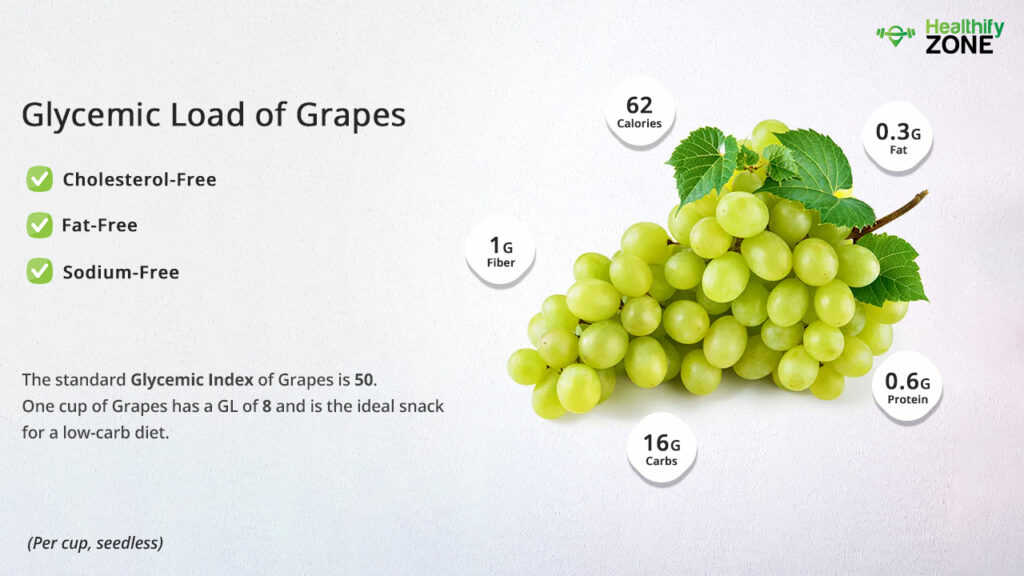The quantification of carbohydrates contained in food along with the pace with which it increases the blood glucose levels is called Glycemic Load. A simple way of making healthy diet choices is following the Glycemic Index. It helps in comparison with alternative sources of nutrients according to one’s blood glucose levels. Glucose is a representative of higher blood glucose response compared to fructose.
Grapes come in various kinds and colors- red, green, black, yellow, and pink. They have a variety of health benefits to offer owing to their high nutrient and antioxidant content. According to the International GI Tables, the glycemic index of grapes is 50. It is an excellent choice for people who aim for fat loss and are on low-carb diets.

Grapes are highly beneficial and tasty, and it comprises healthy nutrients like
- Vitamin K
- Vitamin C
- Thiamine
- Vitamin B-6
- Riboflavin
- Manganese
- Fiber
- Potassium
- Copper
How to Calculate Glycemic Load of Grapes?
The standard Glycemic index of grapes is around 50. The high glycemic index of the fruit helps in reducing the risks related to cardiovascular diseases. If we want to talk about diet, the key to prevent diabetes or any chronic illness is to distribute the carbohydrate consumption content throughout the day and manage the sugar levels in the body correctly— having grapes just before a workout can be a good source of carbohydrates since it is loaded with 17 g of good carbs in a 100 g serving.

The Formula/Procedure For Calculation of Glycemic Index of the Watermelon :
GL = GI * carbs / 100
where
- GL – glycemic load;
- GI – glycemic index;
- and carbs – the amount of carbohydrates in the portion.
| SL.NO | WATERMELON BY WEIGHT IN (g) | GLYCEMIC LOAD |
| 1. | 100 g of Grapes | 8.5 (low) |
| 2. | 250 g of Grapes | 21.25 (high) |
| 3. | 500 g of Grapes | 42.5 (high) |
| 4. | 1 Kg of Grapes | 85 (very high) |
| 5. | One Cup of Grape Juice | 20 (high) |
| 6. | 1 Cup of Grapes (150 g) | 8 (low) |
Are Grapes Safe to Consume If You Have Diabetes?
The sugar content in grapes is high, which might make you wonder whether or not to consume grapes if you are diabetic. The Glycemic Index of grapes is rather high. The compounds present in grapes have been found to lower blood sugar levels. A study was conducted with 38 men who took 20 g of grape extracts every day for a period of 16- weeks. They experienced a decrease in blood sugar levels in comparison to a controlled group. Resveratrol present in grapes increases insulin sensitivity, which betters your body’s ability to use glucose and leads to lower blood sugar levels. However, it is necessary to limit the consumption of grapes.
Can I Eat Grapes During a Fat-Loss Diet?
You can eat grapes on a strict fat-loss diet. If you are looking for good results, you should avoid having more than 100g of grapes in one serving.

- A 100g serving of grapes has a GL of 8.5 which is in the permissible levels.
- A cup of grape juice is something which shoud be taken rarely if you are on a fat-loss diet.
- Grapes as a salad ingredient is premissible in a fat-loss diet.
Can I Eat Grapes During a Low-Carbohydrate Diet?
You can have grapes when you are on a strict low-carb diet. However, it is necessary that you are mindful of the portion size that you consume. Stick to a portion size of 100 g and consume no more than that in one serving.
Are Grapes High in Sugar?
Grapes have 23 g grams of sugar per cup (150 g), so it is rather sugary. Also, it has 26 g of carbohydrates in one cup. So, although very sugary and high in carbs, one can consume it if they are mindful about how much they consume.
- Grapes have anti-inflammatory properties which may prevent chronic diseases by reducing inflammation.
- The delicious fruit is versatile and can easily be incorporated into a healthy diet.